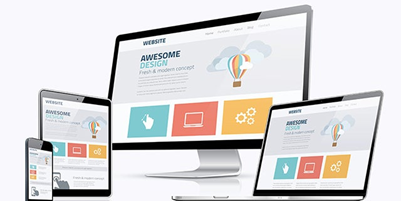E-commerce Website Design
E-commerce websites focus on creating online storefronts that are visually appealing and optimized for sales conversion. The design of an eCommerce website involves understanding and implementing elements that facilitate an easy, secure, and efficient shopping experience for users.
This involves minimizing the steps to complete a purchase by providing clear information and assistance (e.g., size guides and live chat support). Ensure trustworthiness through secure browsing and clear return policies and create a personalized shopping experience with recommendations and tailored content.
A positive user experience helps convert visitors into customers and encourages repeat business and word-of-mouth referrals. The design of an eCommerce website encompasses several elements:
- Product Display and Organization: Products must be displayed clearly and attractively with high-quality images and detailed descriptions. Categories and filters are essential for helping customers find what they’re looking for quickly.
- Navigation and User Interface: Intuitive navigation is crucial in eCommerce design. A well-structured menu, clear calls to action, and a simple checkout process are key to preventing cart abandonment.
- Mobile Responsiveness: With growing number of consumers shopping on their smartphones, a mobile-responsive design is critical. The mobile shopping experience should be as seamless as the desktop version.
- Loading Speed: Fast loading times are essential in eCommerce. Slow websites can lead to frustration and lost sales, as online shoppers often have little patience for delays.
- Branding: The website should reflect the brand’s identity consistently across all pages to create a memorable and trustworthy shopping experience.
A successful eCommerce website should also have a secure and straightforward payment process. Integration of reliable payment gateways is critical for facilitating various payment methods (credit cards, PayPal, e-wallets, etc.) in a secure environment. This also includes ensuring compliance with PCI DSS (Payment Card Industry Data Security Standard) to protect customers’ financial information.
The shopping cart functionality should be smooth and flexible, allowing users to easily add items, modify selections, or continue shopping without losing their cart contents. It should also provide information like shipping costs, taxes, and estimated delivery times. Advanced features such as saving wish lists, out-of-stock notifications, and abandoned cart reminders can enhance the shopping experience and improve sales conversion rates.
Content Management System (CMS) Based Design
A CMS is a software application or related program to create and manage digital content. These platforms are popular for their user-friendly interfaces and flexibility, making website design more accessible to people without extensive coding knowledge.
Most CMS platforms are user-friendly, allowing users with minimal technical skills to build and manage websites. With various plugins and themes, the platforms can be extended to include various functionalities and design options. Many CMSs also come with SEO tools or can be enhanced with SEO plugins, helping optimise search engine content.
They are often free to use, and even premium themes and plugins are generally more affordable than a custom-built website. However, websites built on CMS platforms can become slow if too many plugins or heavy themes are used. Being popular also makes CMS platforms a common target for hackers, necessitating regular updates and website maintenance.
Overview of Popular CMS Platforms
- WordPress: Arguably the most popular CMS in the world, WordPress is known for its ease of use, extensive customization options through themes and plugins, and a large support community. It’s versatile enough for blogs, small business websites, and even larger, more complex sites.
- Joomla: Joomla offers a middle ground between the technical flexibility of Drupal and the user-friendly nature of WordPress. It’s suitable for e-commerce and social networking sites and offers a good deal of customizability with various extensions.
- Drupal: Known for its powerful performance and scalability, it is the go-to for more complex, resource-intensive websites and for those needing a highly customizable CMS. It’s particularly popular among large enterprises and advanced users who require extensive content organization.
While performance and security are limited, these can be mitigated with proper management and customization. For many businesses, the benefits of using a CMS – from ease of use to SEO and customization capabilities – make it an ideal choice for building and managing their online presence.
UX/UI Design Services
UX design focuses on the experience’s overall feel, primarily concerning how users interact with a website. It’s about creating a site that is easy and pleasant to use and efficient and effective in helping users achieve their goals. UX design encompasses the user’s journey and interactions with all aspects of a company’s products and services.
On the other hand, UI design is more about the look and layout of a website. It deals with the specific aspects of how the website is laid out, the colour schemes used, the typography, and all the visual elements on the site. UI design guides the user visually through a website, making the experience aesthetically pleasing and aligned with the brand’s identity.
Good UX/UI design enhances the website’s usability, making it easier for visitors to navigate and find what they want. This ease of use can increase customer satisfaction and higher retention rates. Effective UI design can create an emotional connection with users, making them more likely to engage with the content, trust the brand, and return to the website.
It can significantly boost conversions by simplifying the journey and removing friction points. This includes optimizing the checkout process in eCommerce sites or the sign-up process for online services. Effective UX/UI design rests on several principles:
- Simplicity: The design should be straightforward and uncomplicated. The goal is to make the user’s journey as simple as possible, removing any unnecessary elements or steps.
- Consistency: Consistency in design elements like colours, fonts, and button styles is crucial for a cohesive experience. This also includes maintaining navigational consistency across the website.
- Responsiveness and Accessibility: The design should be accessible and provide a seamless experience across various devices and screen sizes. Additionally, it should be accessible to disabled users, adhering to WCAG guidelines.
- User-Centric Approach: It is fundamental to understand the target audience and design for their needs and preferences. This includes personalized experiences, intuitiveness, and feedback mechanisms.
- Visual Hierarchy: Important elements should be easily noticeable. A clear hierarchy naturally guides users through the site’s most critical parts.
Website Redesign and Update Services
Website redesign and update services involve reevaluating and enhancing its functionality, user experience, and alignment with the brand’s evolving goals. Redesigning a website begins with an in-depth audit of the existing site to identify areas for improvement.
The redesign should prioritize the user experience, focusing on intuitive navigation, mobile responsiveness, and accessibility. Before the final rollout, test the new design with a segment of the audience and refine it based on feedback. Once the site is live, continuous monitoring is key to addressing issues and optimizing performance once the site is live.
Implementing 301 redirects for changed URLs helps maintain link authority and user access. Retaining and optimally repositioning high-performing content within the new design framework is important. Updating meta tags and descriptions and maintaining URL structures, especially for pages with strong SEO performance, is essential. Several indicators suggest a website might need a redesign:
- Outdated Design: If the website looks visually outdated compared to competitors, it can negatively impact the brand’s image and user engagement.
- Poor Performance: Slow loading times, broken links, or not being mobile-responsive are clear signs that a website needs an overhaul.
- Low Conversion Rates: If the website is not effectively converting visitors into customers or leads, it might be time to reevaluate the user journey and design elements.
- Changes in Business Goals: If the business’s goals, branding, or target audience have evolved, the website should reflect these changes.
- SEO and Compliance Issues: Falling search rankings or non-compliance with legal standards (like ADA compliance) are also reasons to consider redesigning.
Graphic Design in Web Design
Graphic design in web design involves strategically using visual elements to enhance user experience, convey brand messages, and effectively guide visitors through a website. Elements like colour, typography, imagery, and layout create an aesthetic that either draws in or repels visitors.
Colours evoke emotions and set the mood of the website, while typography can influence readability and the overall perception of the site. The layout, which involves arranging these elements on a webpage, determines the flow and order in which information is consumed. These elements must be balanced to create visually appealing but also functional and user-friendly websites.
Consistent use of brand colours, logos, typography, and imagery across a website helps reinforce brand recognition and loyalty. These elements must align with the overall brand messaging and values. For example, a brand that stands for sustainability might use earthy tones and nature-inspired graphics. At the same time, a tech company might opt for a sleek, minimalist design with modern fonts and a monochromatic colour palette. Here are some common trends in Singapore.
- Minimalism: The trend of minimalism, characterized by clean, uncluttered layouts and simple colour schemes, focuses on functionality and ease of use.
- Bold Typography: Large, bold fonts are becoming popular for making a statement and highlighting important content.
- Custom Illustrations and Animations: These add a unique and creative touch to websites, helping brands stand out and engagingly convey their message.
- Dynamic and Interactive Elements: Interactive graphics that respond to user actions can significantly enhance user engagement and interest.
- Dark Mode Aesthetics: The use of dark backgrounds with light text, known for its visual appeal and reduced eye strain, is gaining popularity.
- 3D Elements and Immersive Experiences: The integration of 3D graphics and immersive elements offers a new level of interactivity and realism, enhancing user engagement.
Choosing the Right Website Design Service
Before searching for a website design service, clearly understand specific needs and goals. The first step in choosing a web design service involves thoroughly assessing the website’s objectives.
This process should begin by defining the website’s primary purpose, whether it’s for e-commerce, lead generation, brand awareness, or information dissemination. Understanding the target audience is crucial, as their online behaviours and preferences will significantly influence design choices. The website should reflect the brand identity, encompassing its tone, style, and messaging.
Additionally, functionality requirements, such as system integrations, e-commerce capabilities, or interactive elements, must be clearly outlined. Equally important is establishing a realistic budget for the design project, considering the available resources for ongoing maintenance and updates. Here are some tips on selecting a web design service provider in Singapore:
- Portfolio Review: Examine the provider’s portfolio to assess their style, versatility, and experience, especially in projects similar to your requirements.
- Client Testimonials and References: Client feedback can provide insights into the provider’s reliability, responsiveness, and quality of work.
- Expertise in Current Trends and Technologies: Ensure the provider is up-to-date with the latest design trends and web technologies, including responsive design and SEO best practices.
- Communication and Collaboration: Opt for a service provider who communicates effectively and is open to collaboration, which is crucial for the project’s success.
- After-Support Services: Check the availability of ongoing support and maintenance services post-launch.
ARCC, based in Singapore, specializes in providing streamlined and impactful website design services. We focus on delivering tailored web development solutions that align with the unique business goals and brand identity. In addition to their design and development services, we provide ongoing website maintenance support, helping businesses keep websites up-to-date with evolving digital trends. Feel free to contact us for a no-obligation digital marketing consultation.








